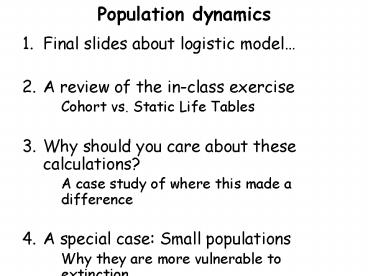Population dynamics PowerPoint PPT Presentation
1 / 24
Title: Population dynamics
1
Population dynamics
- Final slides about logistic model
- A review of the in-class exercise
- Cohort vs. Static Life Tables
- Why should you care about these calculations?
- A case study of where this made a difference
- A special case Small populations
- Why they are more vulnerable to extinction
2
Logistic
3
Logistic
4
Logistic
New recruits each timestep
5
Logistic
6
Logistic
Rate of popn growth per individual (NOT CONSTANT)
7
Population abundance (N)
Time
Highest population increase at intermediate
densities
dN/dt
Density (N)
Declining per capita contribution
dN/dt/N
Density (N)
8
Desert tortoises, Gopherus spp.
Mark-recapture data following individuals over 3
surveys (one survey every 5 years) Static life
tablewith some cohort info
sx (survival) from stage x to x1
0.27
0.24
0.24
0.10
0.21
0.11
9
Desert tortoises, Gopherus spp.
bx
Juveniles (0-5)
Young Adults (6-10)
Middle age (11-15)
Older Adults (16-20)
sx
sx
sx
1
10.24 0.24
10.240.1 0.024
10.240.10.110.003
10
Desert tortoises, Gopherus spp.
Mark-recapture data following individuals over 3
surveys (one survey every 5 years)
1.48
18.6
0.70
7.8
Generation time, G Sxlxbx / R0
18.6/1.48 12.53
7.8/0.70 11.20
Intrinsic rate of population growth
ra ln(R0) / G
ln(1.48)/12.53 0.03
ln(0.70)/11.20 -0.03
11
Why?? Poaching/Harvest Egg predators Beach
development Collision with ships Fishing bycatch
12
Crouse builds a model based on life-table (matrix
model)
Crouse et al. 1987 Ecology
Eggs/hatch 1yr
Sm juveniles 7yrs
Lg. juveniles 8yrs
Subadults 6yrs
Adults gt32yrs
Norbert Wu
13
She systematically changed the survival and
fecundity rates.. -projected the population
growth rate into the future (r) -which one
results in the biggest change in r -determines
the most sensitive life-stage for population
growthfocus protection efforts
Even 100 survival of eggs/hatchlings doesnt
reverse decline!
Where should we invest conservation efforts to
reverse population decline?
Norbert Wu
changed survival by 10 (0.67 to 0.77)
14
How to make models more realistic?
- Deterministicthis is what weve considered so
far (demographic rates dont change) - Stochastic- adding random noise or variation in
rates makes the models more realistic (but also
more complex) - Especially important for accurately predicting
small populations - Most endangered species, some exploited species
15
Three reasons why populations may fail to
increase from low density
- rlt0 (deterministic decline at all densities)
- Depensation individual performance declines at
low population size (deterministic decline at low
densities) - Below Minimum Viable Population susceptible to
stochastic decline - (demographic, environmental, genetic)
16
Depensation
- Positive density dependence-- individuals do
worse at low population size - Resources are not limiting, but
- Mates difficult to find (Allee effect)
- Lack of neighbors may reduce foraging or breeding
success, vulnerability to predators (flocking,
schooling)
17
Red abalone
Mechanism of depensation At low densities
successful spawning declines.mates too far away
Consequence of depensation Population growth
rate is LOWER with fewer individuals
18
Deterministic decline in Snake R. Chinook salmon
across a wide range of densities (rlt0)
Kareiva et al. 2000 Science
19
Draw a hypothetical graph of fecundity as a
function of population size for passenger pigeons
No density dependence
As would be the case for density-independent
population growth (geometric/exponential)
20
Draw a hypothetical graph of fecundity as a
function of population size for passenger pigeons
Density dependent population regulation (logistic)
Births/individual/year
Population density (N)
Carrying capacity (K) when dN/dt/N0
21
Draw a hypothetical graph of fecundity as a
function of population size for passenger pigeons
Depensation
Births/individual/year
Density dependent population regulation (not
logistic)
Population density (N)
Carrying capacity (K) when dN/dt/N0
22
Small populations
- Dynamics governed by uncertainty
- compared to large population (law of averages)
- Demographic stochasticity random variation in
sex ratio at birth, number of deaths, number
reproducing - (individual-levelbut when few individuals can
have a big effect) - Environmental stochasticity decline in
population numbers due to natural disasters or
more minor environmental events - (effect of ENSO for Galapagos penguins?)
23
Galapagos penguins and ENSO
- Galapagos penguin declines
- (IUCN Red List)
- -northern most penguin species
- -highly dependent on abundant fish (upwelling)
- 1982-1983 El Nino event 77 reduction in
population - 1988-1989 El Nino event 66 reduction in
population - Other factors fishing, exotic egg predators,
oil spills
24
Small populations
- Genetic stochasticity loss of genetic variation
due to small numbers in reproducing population - Inbreeding depression
- Reduction in genetic diversity
- Genetic drift
- Genetic problems probably occur slower than
demographic problems at small population sizes - BUT, reduced genetic variation has big effects
for recovering populations (genetic bottlenecks)

